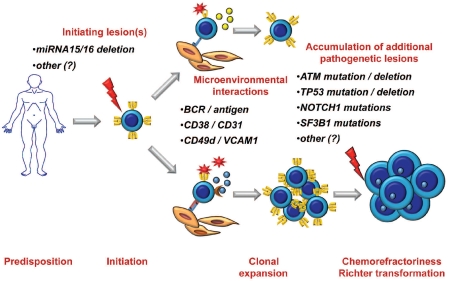Figure 1.
A proposed model of CLL multistep pathogenesis and of its clinical implications. Although the overwhelming majority of cases do not run in families, the genetic background of the host might favor predisposition to CLL in a fraction of patients. A founding genetic lesion, conceivably represented by loss of miRNA15/16 in a substantial fraction of CLL, initiates clonal expansion, that is then favored and promoted by interactions of leukemic cells with antigens and/or the microenvironment. During their clinical course, some patients gain molecular alterations of genes (TP53, ATM, NOTCH1, SF3B1, and possibly other) that confer a higher degree of clinical aggressiveness which translates into refractoriness to conventional treatments and potential of transformation to diffuse large B cell lymphoma known as Richter’s syndrome.

